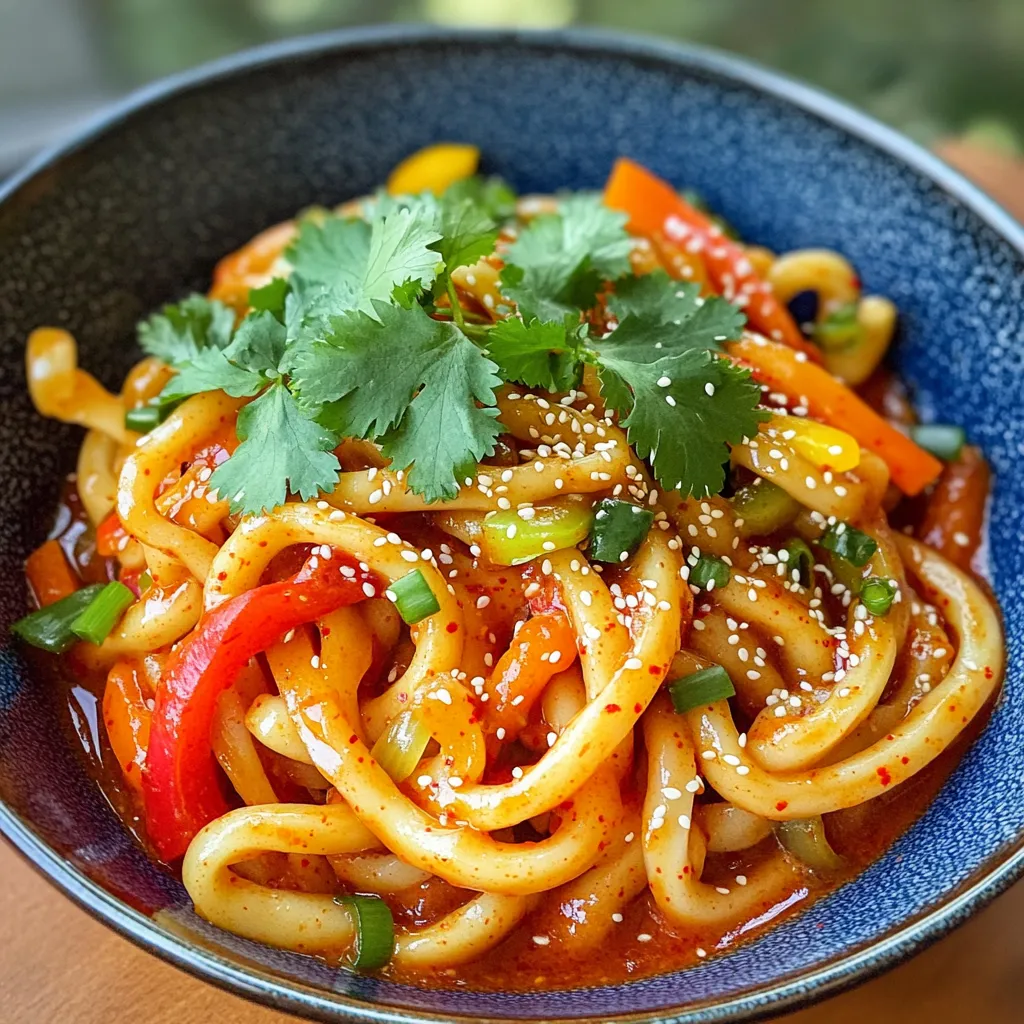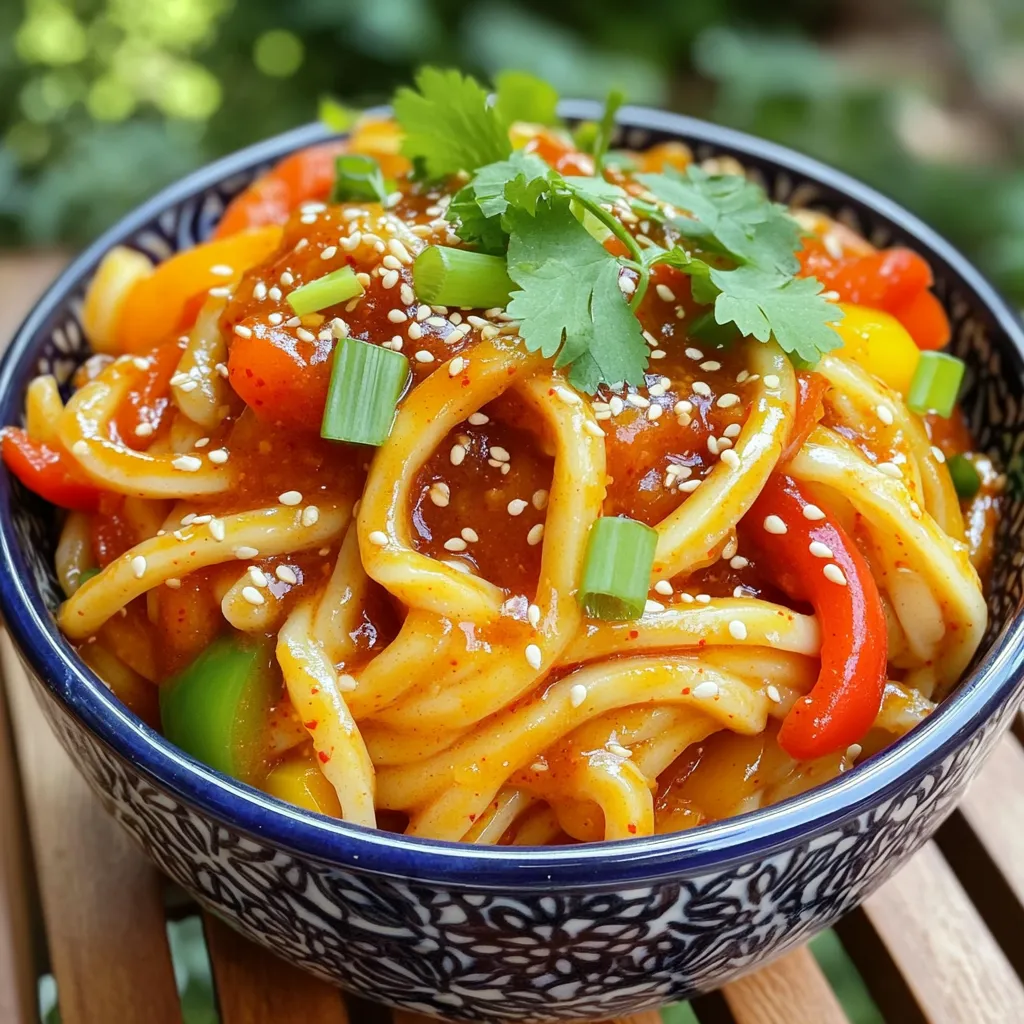Craving a quick and tasty meal? These Minute Spicy Gochujang Udon Noodles are your answer! They’re simple to make and bursting with flavor. In just a few steps, you can whip up a delicious dish that satisfies your taste buds. I’ll guide you through every ingredient and every step, making this meal idea perfect for busy weeknights. Ready to spice up your dinner? Let’s get cooking!
Ingredients
List of Ingredients for Minute Spicy Gochujang Udon Noodles
- 200g udon noodles
- 2 tablespoons gochujang (Korean chili paste)
- 1 tablespoon soy sauce
- 1 tablespoon sesame oil
- 1 tablespoon honey or maple syrup
- 1 teaspoon minced garlic
- 1 teaspoon minced ginger
- 1 small carrot, julienned
- 1 bell pepper (any color), thinly sliced
- 3 green onions, chopped
- 2 teaspoons sesame seeds
- Fresh cilantro leaves for garnish
- Optional: fried tofu or a soft-boiled egg for protein
Importance of Each Ingredient
Each ingredient adds flavor and texture to the dish. Udon noodles are thick and chewy, making them perfect for this recipe. Gochujang gives a spicy kick and a rich flavor. Soy sauce adds saltiness while sesame oil brings a nutty taste. Honey or maple syrup balances the spice with sweetness. Garlic and ginger offer warmth and depth. Fresh veggies like carrot and bell pepper add crunch and color. Green onions and sesame seeds provide freshness and garnish. Optional proteins like tofu or egg enhance the meal’s heartiness.
Suggested Substitutes
If you cannot find udon noodles, you can use rice noodles or spaghetti. For a gluten-free option, choose gluten-free noodles. If gochujang is unavailable, try sriracha or chili paste, but adjust the amount to your spice level. You can replace honey with agave syrup or omit it for a low-sugar version. Instead of sesame oil, olive oil works fine, though it changes the flavor slightly. Feel free to swap veggies based on what you have at home, like zucchini or broccoli.
Step-by-Step Instructions
Cooking Udon Noodles
First, you need to cook the udon noodles. Bring a pot of water to a boil. Add 200g of udon noodles to the pot. Cook them for about 6 to 8 minutes, or until they are just tender. Stir them occasionally to stop them from sticking. Once done, drain the noodles and set them aside.
Preparing the Spicy Sauce
Next, let’s make the spicy sauce. In a small bowl, combine 2 tablespoons of gochujang, 1 tablespoon of soy sauce, and 1 tablespoon of sesame oil. Add 1 tablespoon of honey or maple syrup for sweetness. Now, stir in 1 teaspoon of minced garlic and 1 teaspoon of minced ginger. Whisk it all together until smooth. This sauce packs a spicy punch and brings the dish to life.
Combining Ingredients in the Pan
Now it’s time to combine everything. Heat a large pan or wok over medium heat. Add the julienned carrot and thinly sliced bell pepper to the pan. Sauté these for about 2 to 3 minutes until they start to soften. Then, add the cooked udon noodles to the pan. Pour the spicy sauce over the noodles and toss everything together. Mix until the noodles and veggies are well coated and heated through, about 2 to 3 minutes. Remove from heat. Finally, stir in chopped green onions and 2 teaspoons of sesame seeds. Serve the noodles in bowls and garnish with fresh cilantro. Enjoy your meal!
Tips & Tricks
How to Achieve the Perfect Udon Texture
To get the best udon noodles, cook them just right. Follow the package instructions closely. Generally, this means boiling them for 6-8 minutes. Check for doneness by tasting a noodle. It should be soft but firm. Drain them well to avoid sogginess. Rinse briefly under cold water to stop the cooking process. This keeps the texture perfect for your dish.
Enhancing Flavor and Spice Level
Gochujang brings a unique heat to your dish. To make it even spicier, add more gochujang based on your taste. You can also mix in some chili flakes or fresh jalapeños for an extra kick. If you prefer a milder flavor, lessen the gochujang. The sauce combines well with honey and soy sauce. Adjust these to balance the spice and sweetness to your liking.
Time-Saving Tips for Busy Cooks
Use pre-cut veggies to save time. Many grocery stores sell julienned carrots and sliced bell peppers. This cuts down your prep time a lot. Cook the udon noodles while you prepare the sauce. Multitasking helps you finish the meal quicker. You can also make the spicy sauce ahead of time and store it in the fridge. This way, you can enjoy this tasty meal even on your busiest days!

Variations
Protein Additions: Tofu, Chicken, or Egg
You can boost the protein in your udon noodles easily. Tofu is a great choice. It soaks up flavors well. Use fried or baked tofu for texture. You can also add cooked chicken. Slice it thin for quick mixing. A soft-boiled egg on top adds creaminess. The yolk mixes in nicely with the sauce. Each protein adds a unique taste and makes the meal more filling.
Vegetable Swaps and Add-ins
Feel free to play with the vegetables. You can swap carrots and bell peppers for others. Broccoli, snap peas, or mushrooms work well too. They all add color and crunch. You can even toss in some spinach at the end. It wilts nicely and adds nutrients. Get creative with what you have on hand!
Gluten-Free Options
Want a gluten-free meal? You can use rice noodles instead of udon. They cook fast and taste great with the sauce. Check the label for gluten-free options. Also, make sure your soy sauce is gluten-free. There are many brands available. This way, you can enjoy this dish without worry!
Storage Info
How to Store Leftovers
To store your leftover spicy gochujang udon noodles, let them cool first. Once cool, place them in an airtight container. Make sure to seal it well. You can keep them in the fridge for up to three days. This helps keep the noodles fresh and tasty.
Reheating Tips for Best Results
When you are ready to enjoy the noodles again, reheating them is easy. Place the noodles in a pan over medium heat. Add a splash of water or broth to keep them moist. Stir them often to heat evenly. You can also use the microwave. Just cover the bowl and heat for one to two minutes. Stir halfway through for even heat.
Shelf Life of Prepared Noodles
Prepared spicy gochujang udon noodles last about three days in the fridge. If you store them in the freezer, they can last up to three months. To freeze, place them in a freezer-safe bag. Remove as much air as possible before sealing. When ready to eat, thaw them in the fridge overnight before reheating.
FAQs
Can I make these udon noodles vegan?
Yes, you can make these udon noodles vegan. To do this, swap honey for maple syrup. Both work well and keep the dish sweet. You can also add fried tofu for protein. This makes the meal hearty and satisfying.
What can I use instead of gochujang?
If you don’t have gochujang, try using sambal oelek. This chili paste adds heat but lacks sweetness. You can mix in a bit of sugar or maple syrup to mimic gochujang’s flavor. Another option is sriracha, but it is spicier and more liquid.
How long does it take to cook udon noodles?
Cooking udon noodles is quick and easy. It takes about 6-8 minutes to cook them until tender. Always check the package instructions for best results. Once cooked, drain and set them aside to mix with your sauce.
This article covered how to make Minute Spicy Gochujang Udon Noodles. We explored each ingredient and its importance, plus some substitutes. Step-by-step instructions helped you navigate cooking the noodles and sauce. I shared tips for perfect texture and flavor, along with variations to make this dish your own. Lastly, we discussed how to store leftovers effectively. Now, you can enjoy this tasty dish with confidence. Give it a try and let your kitchen shine!


